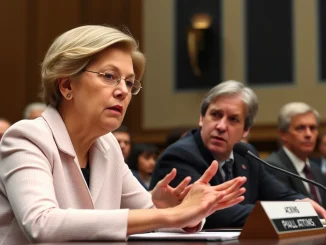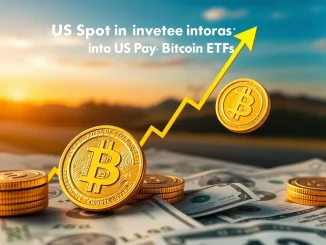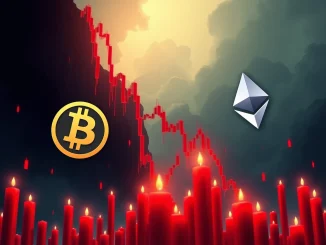
In the ever-evolving world of cryptocurrency and blockchain technology, trust and transparency are paramount. Imagine a digital asset ecosystem where clarity reigns, and the rules are not just suggested but codified into the very fabric of the tokens themselves. This vision is rapidly becoming a reality thanks to Vana (VANA), an EVM-compatible blockchain, which has just introduced the groundbreaking VRC-20 standard. This isn’t just another update; it’s a potential game-changer aimed at fundamentally enhancing digital asset transparency. Let’s dive into what this exciting development means for the future of crypto and how it could impact you.
What Exactly is the VRC-20 Standard and Why Does it Matter for Digital Asset Transparency?
The VRC-20 standard is more than just a technical specification; it’s a commitment to clarity and reliability in the digital asset space. Built upon the Vana blockchain, which is known for its compatibility with the Ethereum Virtual Machine (EVM), VRC-20 is designed to bring a new level of transparency to data-driven digital assets. But what does this really mean?
In essence, the VRC-20 standard mandates several key features for tokens created under its umbrella. These aren’t optional suggestions; they are core requirements that aim to foster trust and predictability. Let’s break down the critical components:
- Fixed Token Supply: One of the foundational principles of sound economics is understanding scarcity. VRC-20 tokens will have a predetermined, fixed supply. This eliminates the uncertainty and potential manipulation associated with inflationary token models where the supply can be altered arbitrarily. Knowing the exact total number of tokens that will ever exist provides a solid base for value assessment and reduces the risk of sudden supply shocks.
- Clearly Defined Governance Rules: Governance in the crypto world can sometimes feel like the Wild West. VRC-20 seeks to bring order and structure by mandating explicit governance rules for tokens. This means that how decisions are made regarding the token, its future development, and any changes to its functionality will be transparently laid out from the outset. This reduces ambiguity and potential for centralized control or unexpected shifts in project direction.
- Liquidity Conditions: Liquidity is the lifeblood of any trading market. The VRC-20 standard addresses this head-on by requiring clear liquidity conditions for tokens. This likely implies pre-defined mechanisms or commitments to ensure that tokens are readily tradable and accessible in the market. This is crucial for preventing market manipulation and ensuring fair access for all participants.
These mandates collectively contribute to a more reliable and predictable environment for digital asset trading. By standardizing these crucial aspects, VRC-20 aims to move beyond the often opaque and volatile nature of some digital assets, fostering a more mature and trustworthy market.
Benefits of the VRC-20 Standard: How Does it Enhance Trust?
The introduction of the VRC-20 standard is not just about ticking boxes; it’s about unlocking tangible benefits for users and the broader crypto ecosystem. Let’s explore some key advantages:
- Increased Investor Confidence: Transparency breeds trust. By providing clear and upfront information about token supply, governance, and liquidity, VRC-20 can significantly boost investor confidence. Investors are more likely to engage with assets when they understand the underlying mechanics and rules of engagement. This is especially crucial for attracting institutional investors and mainstream adoption.
- Reduced Risk of Manipulation: The fixed supply and pre-defined liquidity conditions inherent in the VRC-20 standard act as built-in safeguards against market manipulation. Knowing the supply is capped eliminates fears of sudden token inflation, and clear liquidity provisions ensure that markets are less susceptible to artificial pumps and dumps.
- Improved Price Discovery: Transparency in governance and tokenomics contributes to more efficient price discovery. When market participants have a clearer understanding of an asset’s fundamentals and rules, they can make more informed decisions, leading to fairer and more stable pricing.
- Streamlined Regulatory Compliance: As regulations in the crypto space continue to evolve, standards like VRC-20 can play a vital role in facilitating compliance. By proactively incorporating transparency and accountability, projects utilizing VRC-20 may find it easier to navigate the evolving regulatory landscape.
- Fostering a More Mature Ecosystem: Ultimately, the VRC-20 standard contributes to the maturation of the digital asset ecosystem. By promoting best practices and emphasizing transparency, it helps move the industry away from speculative hype and towards sustainable, reliable growth.
Vana Blockchain: The Foundation for VRC-20 and Digital Asset Innovation
It’s important to understand that the VRC-20 standard is built upon the Vana blockchain. Vana itself is an EVM-compatible blockchain, which means it’s designed to work seamlessly with applications and tools developed for the Ethereum ecosystem. This compatibility is a significant advantage as it allows developers familiar with Ethereum to easily build and deploy projects on Vana, leveraging the benefits of the VRC-20 standard.
Vana’s choice to champion digital asset transparency through the VRC-20 standard signals a commitment to building a more trustworthy and accessible blockchain environment. By focusing on data-driven digital assets, Vana is positioning itself at the forefront of a potentially transformative shift in how digital assets are created, managed, and traded.
Challenges and Considerations for the VRC-20 Standard
While the VRC-20 standard offers significant promise, it’s also important to acknowledge potential challenges and considerations:
- Adoption Rate: The success of VRC-20 hinges on its adoption by projects and developers. While the benefits are clear, encouraging widespread adoption requires community engagement, developer support, and compelling use cases that showcase the advantages of the standard.
- Flexibility vs. Rigidity: While standardization brings benefits, there’s also a balance to be struck with flexibility. Mandating fixed token supply, governance, and liquidity might not be suitable for every type of digital asset or project. The VRC-20 community will need to ensure the standard is adaptable enough to accommodate diverse needs while maintaining its core principles of transparency.
- Enforcement and Auditing: Ensuring that projects claiming to adhere to the VRC-20 standard actually do so will be crucial. Mechanisms for auditing and verifying compliance may need to be developed to maintain the integrity of the standard and prevent misrepresentation.
- Education and Awareness: For the VRC-20 standard to truly take off, there needs to be widespread education and awareness among developers, investors, and the broader crypto community. Clearly communicating the benefits and technical details of the standard will be essential for driving adoption.
Examples of Potential VRC-20 Applications: Beyond Traditional Tokens
The focus on data-driven digital assets opens up exciting possibilities for the application of the VRC-20 standard. Think beyond traditional cryptocurrencies and consider these examples:
- Data Tokens: In an increasingly data-driven world, tokens representing ownership or access rights to specific datasets could greatly benefit from the transparency and reliability offered by VRC-20. Imagine tokens representing anonymized healthcare data, environmental sensor data, or financial market data – all governed by clear VRC-20 rules.
- Intellectual Property Tokens: Tokenizing patents, copyrights, or trademarks using VRC-20 could create a more transparent and efficient market for intellectual property. The fixed supply and governance rules could help establish clear ownership and usage rights.
- Supply Chain Transparency Tokens: Tokens tracking goods throughout a supply chain could utilize VRC-20 to ensure data integrity and transparency. Imagine tokens representing batches of organic produce, luxury goods, or pharmaceuticals, with verifiable origins and provenance tracked on the Vana blockchain.
- Decentralized Identity Tokens: While more complex, even aspects of decentralized identity could potentially leverage VRC-20 principles. Tokens representing verifiable credentials or attributes could benefit from standardized governance and transparency.
These examples highlight the potential of the VRC-20 standard to extend beyond simple cryptocurrencies and into a wider range of data-driven applications, all underpinned by a commitment to transparency.
Actionable Insights: What Does VRC-20 Mean for You?
So, what should you take away from the introduction of the VRC-20 standard?
- For Investors: Keep an eye on projects launching VRC-20 tokens. The standard’s emphasis on transparency could indicate a higher level of reliability and reduced risk compared to projects with less clear tokenomics and governance. Do your due diligence, but recognize VRC-20 as a potentially positive signal.
- For Developers: Consider building your next data-driven digital asset project on the Vana blockchain and utilizing the VRC-20 standard. It could provide a competitive advantage by instilling greater trust in your project and streamlining potential regulatory compliance.
- For the Crypto Community: Support initiatives like VRC-20 that promote transparency and best practices in the digital asset space. A more transparent and reliable ecosystem benefits everyone in the long run.
Conclusion: A Transparent Future with VRC-20
Vana’s introduction of the VRC-20 standard marks a significant step forward in the quest for greater digital asset transparency. By mandating fixed token supply, governance rules, and liquidity conditions, VRC-20 sets a new benchmark for reliability and trust in the crypto space. While adoption and ongoing development are crucial, the potential benefits are undeniable. As the digital asset landscape continues to mature, initiatives like VRC-20 that prioritize transparency will be essential for fostering widespread adoption and building a sustainable future for blockchain technology. The dawn of truly transparent digital assets may well be upon us, and the VRC-20 standard is poised to play a leading role in this exciting evolution.



